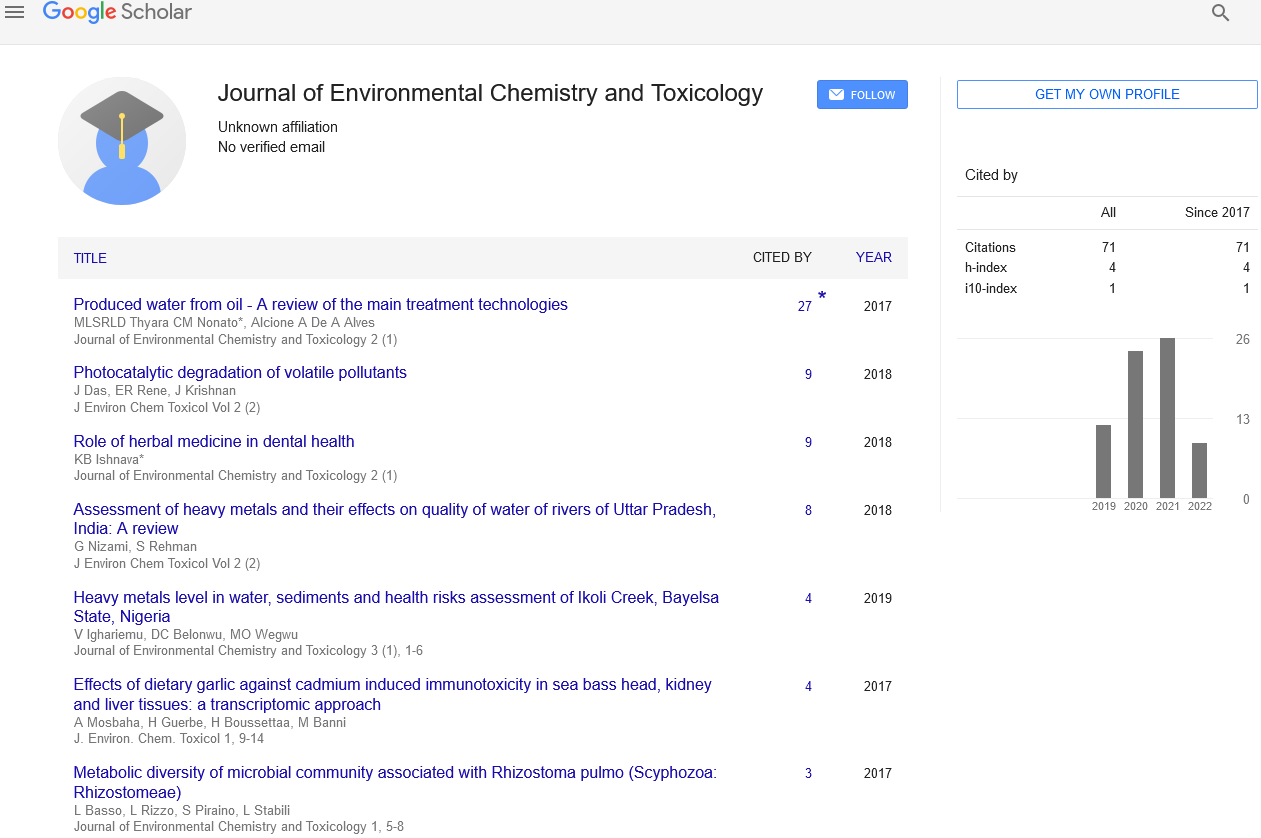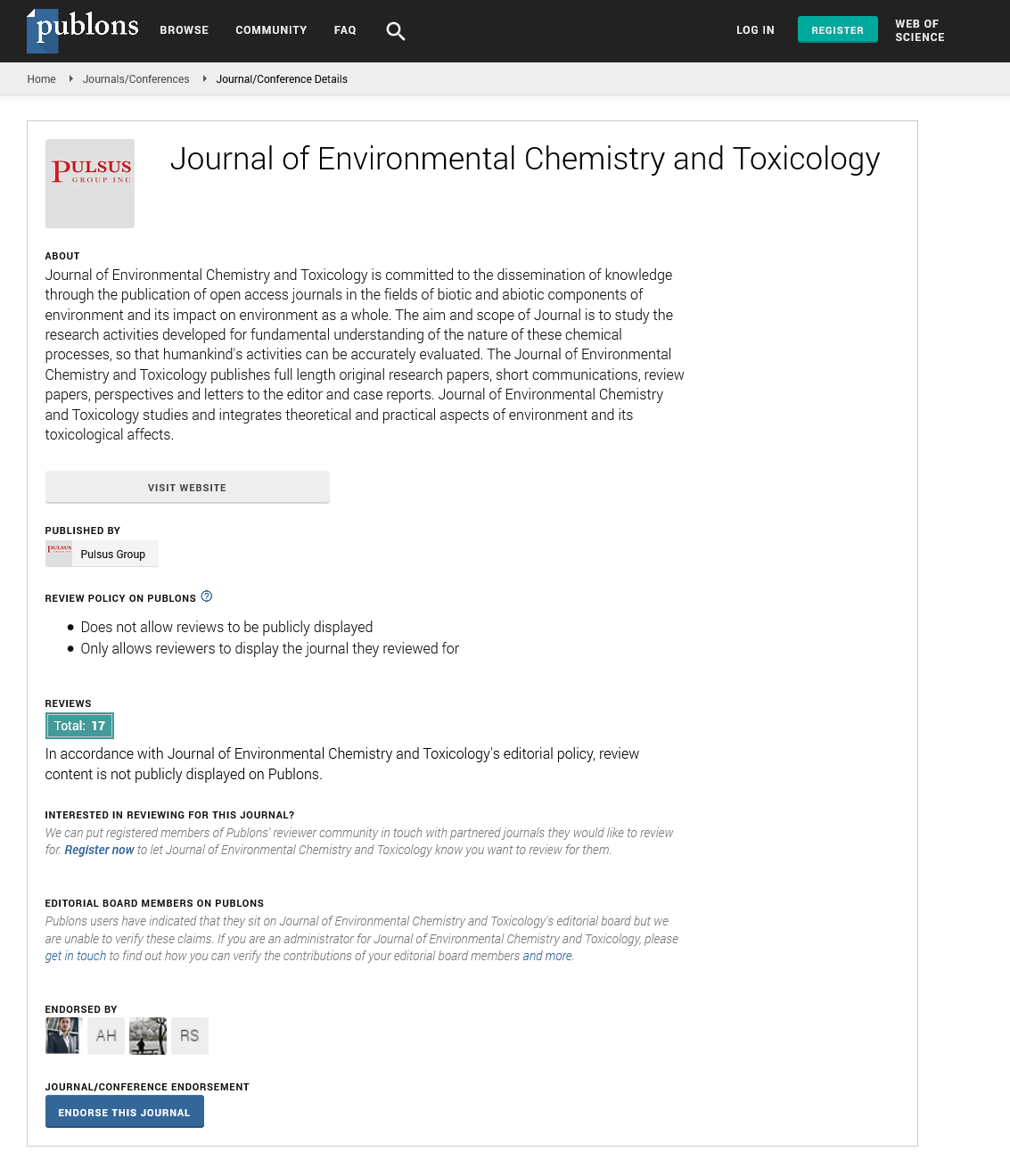Organic Manure
Received: 02-Sep-2022, Manuscript No. PULJECT-22-5256; Editor assigned: 02-Sep-2022, Pre QC No. PULJECT-22-5256(PQ); Accepted Date: Sep 15, 2022; Reviewed: 03-Sep-2022 QC No. PULJECT-22-5256(Q); Revised: 05-Sep-2022, Manuscript No. PULJECT-22-5256(R); Published: 20-Sep-2022, DOI: 10.37532/jmap.2022 .6(5); 01-12
Citation: Anushka Anand. Organic manure. J Environ Chem Toxicol. 2022; 6(5):1-2.
This open-access article is distributed under the terms of the Creative Commons Attribution Non-Commercial License (CC BY-NC) (http://creativecommons.org/licenses/by-nc/4.0/), which permits reuse, distribution and reproduction of the article, provided that the original work is properly cited and the reuse is restricted to noncommercial purposes. For commercial reuse, contact reprints@pulsus.com
Abstract
Organic farming offers an alternative to more widespread, high input farming practices that use synthetic fertilizers, fungicides and pesticides. It is based on the idea that the soil is a living system so these synthetic products are largely excluded from organic farms. Organic agriculture relies on crop rotation, animal manures, crop residues, green manures and the biological control of pests and diseases to maintain soil health and productivity. Organic crops are often of higher value than conventional ones and the volume of organic crops shows a continually increasing production trend. The sale of crops labeled as organic or biological is highly regulated in most advanced markets. The environmental impact of organic farming is low and can be seen as a way of cleaning up and improving degraded agricultural land. Soil nutrient management is necessary to maintain the constant productivity of nursery systems as well as good quality soil. Wheat, Pomegranate, Sunflower seedlings were treated with an organic manure mixture of Cow manure, Buffalo manure and Goat manure.
https://tipobette.com https://vdcasinoyagiris.com https://venusbetting.com https://sahabetting.com https://sekabete.com https://sahabete-giris.com https://onwine-giris.com https://matadorbet-giris.com https://casibomkayit.com https://casibomba.com https://casiboms.com https://casinoplusa.org https://casibomlink.com https://yenicasibom.com https://jojobetegiris.com https://jojoguncel.com https://jojobetyeni.com https://girisgrandbetting.com https://pashabetegiris.com https://grandbettingyeni.com
Keywords
Organic crops; Organic farming
Introduction
India has been witnessing a spate of month-long farmer protests across the country, particularly in the national capital, against the recently introduced farm bills by the central government. One of the major reasons behind these agitations, including calls for repealing the law, is that farmers were not actively involved in the policymaking cycle of these laws, which they deem as unjust, and only catering to large corporate houses.Organic manure has a number of shortcomings, including low nutrient content, slow decomposition, and different nutrient compositions depending on its organic materials, compared to chemical fertilizers. However, organic manure has multiple benefits due to the balanced supply of nutrients, including micronutrients, increased soil nutrient availability due to increased soil microbial activity, the decomposition of harmful elements, soil structure improvements and root development, and increased soil water availability. In agricultural fields, organic manure that is produced from animal byproducts has been utilized to overcome environmental contamination and plant productivity reductions that result from the constant utilization of chemical fertilizers. Recycling waste from the livestock industry prevents environmental contamination and reduces treatment costs. At the same time, it promotes soil improvements and agricultural productivity. However, the simultaneous use of chemical fertilizer and organic manure has revealed diverse results relative to A brief study has found that organic manure increased the soil concentrations of organic carbon, nitrogen, phosphorus, and potassium, thus highlighting its importance in tropical farmland, which lacks organic matter. Most studies in agricultural fields have reported that the mixed use of chemical fertilizer and organic manure decreases the damage that can be induced by chemical fertilizers and improves crop productivity.
To maintain consistently high biomass productivity, soil nutrient management is essential, and fertilization is the only way to supply soil nutrients within a short period of time. Adegbidi et al. (2003) reported that fertilization costs accounted for 20%–30% of the total production costs in biomass production. However, the effects of the mixed use of chemical fertilizer and organic manure on the growth of trees and soil fertility vary substantially according to the fertilizer amounts and the organic manure characteristics. The amount of organic manure required is mainly determined by the nitrogen content. However, special attention needs to be paid because the ratios of nutrients other than nitrogen can differ from the trees’ requirements. Pure organic farming means avoiding all unnatural chemicals. In this process of farming, all the fertilisers and pesticides are obtained from natural sources such as bone meal or blood meal. Integrated organic farming includes the integration of pest management and nutrients management to achieve ecological requirements and demands
Wheat
Wheat is a cereal grain. People eat it most often in the form of bread. It is a kind of grass whose fruit is a "head of wheat" with edible seeds. It was first grown in the Levant, a region of the Near East. Now it is cultivated worldwide.
Kingdom:Plantae Clade:Tracheophytes Clade:Angiosperms Clade:Monocots Clade:Commelinids Order:Poales Family:Poaceae Subfamily:Pooideae Supertribe:Triticodae Tribe:Triticeae Genus:Triticum L.
Pomegranate
A pomegranate is a sweet, tart fruit with thick, red skin. While the skin is not edible, it holds hundreds of juicy seeds that you can eat plain or sprinkle on salads, oatmeal, hummus, and other dishes. Bottled pomegranate juice is also an easy way to enjoy some of the health benefits of this delicious fruit.
Kingdom:Plantae Clade:Tracheophytes Clade:Angiosperms Clade:Eudicots Clade:Rosids Order:Myrtales Family:Lythraceae Genus:Punica Species: P. granatum.
Sunflower
The common sunflower (Helianthus annuus) is a large annual forb of the genus Helianthus grown as a crop for its edible oil and seeds. This sunflower species is also used as wild bird food, as livestock forage (as a meal or a silage plant), in some industrial applications, and as an ornamental in domestic gardens. Kingdom:Plantae Clade:Tracheophytes Clade:Eudicots Clade:Asterids Clade:Angiosperms Order:Asterales Family:Asteraceae Subfamily:Asteroideae Tribe:Heliantheae Subtribe:Helianthinae Genus:Helianthus
Now we will compare the effect of all manures on three different plants in order to determine the best suitable manure for the plants with the help of collected data throughout the experiment.The experiment is performed within the span of four weeks on five different sample of each three plants
Experimental treatments
Organic manure consisting of 20% Cow manure, 20% Buffalo manure, 20% Goat manure was used in this study. Two 20 kg bags were randomly selected to measure the moisture (47.1%), nutrient, and heavy metal content boards that were placed to a depth of 5 cm and a height of 5 cm from the ground in order to prevent fertilizer loss due to rainfall.these all settlements are kept as it is throughout the four weeks and the growth is measured.
Growth and nutrient responses
Presence of Goat manure is more as compared to buffalo manure and cow manure. The growth of stem leaves branches are measured in the spam of four weeks and the full positive growth is clearly shown through tablular information. The effect of goat manure on the experimental plant is more because the goat has been feeden with more green leaves and household food remainings. And the manure accumulated is 2 years old to 4 years old.
A literature review on best practices regarding the rehabilitation of patients who underwent heart valve repair or replacement surgery and those with cardiovascular diseases was undertaken. Online database such as Google Scholar, Medline and PubMed which contains scholarly published guidelines, position papers and consensus statements on cardiac rehabilitation were identified on the electronic database of the University of Namibia (UNAM) library. Peer reviewed publications and scholarly guidelines and position papers on cardiac rehabilitation were selected. The search terms were guided by the title of the study, goals and objectives mainly focused on cardiac rehabilitation of patients after heart valve surgery.
International guidelines, position statements/papers and policy documents, consensus statement, frameworks for cardiac rehabilitation available in the English language published since 1993 to 2018 from high and low-income countries were identified through a search of electronic database of Google Scholar, Medline and PubMed. The World Health Organization (WHO) Expert Committee on rehabilitation after cardiovascular diseases prepared for guidelines with special emphasis for developing countries on cardiac rehabilitation for low-resource settings was also included in the review. The core components of cardiac rehabilitation guidelines of cardiovascular conditions were extracted and compared in order to identify components which are feasible and affordable to be delivered in Namibian context.
Given that there are limited empirical studies on heart valve surgeries, this review was based on the findings found on patients with cardiovascular diseases, heart failure, and Coronary Artery Bypass Graft (CABG).






